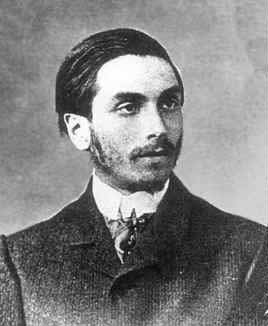


 تاريخ الرياضيات
تاريخ الرياضيات
 الرياضيات في الحضارات المختلفة
الرياضيات في الحضارات المختلفة 
 الرياضيات المتقطعة
الرياضيات المتقطعة
 الجبر
الجبر
 الهندسة
الهندسة 
 المعادلات التفاضلية و التكاملية
المعادلات التفاضلية و التكاملية 
 التحليل
التحليل
 علماء الرياضيات
علماء الرياضيات |
Read More
Date: 31-5-2017
Date: 31-5-2017
Date: 22-5-2017
|
Died: 15 August 1922 in France

Pierre Boutroux's father, Émile Boutroux, was a famous philosopher of science. His mother was Aline Catherine Eugénie Boutroux who was a sister of Poincaré and so he was also related to the other men of great distinction in that family.
Boutroux was educated in Paris at the École Normale Supérieure and he received his licentiate with a thesis, which was published by the University of Paris, L'imagination et les mathématiques selon Descartes. Following this he was appointed as a lecturer in mathematics at the University of Montpellier before becoming professor of integral calculus at Poitiers in 1908.
Although Boutroux held this chair in Poitiers for twelve years he spent much of the time at other institutions. He spent 1909 as a visiting professor at the University of Nancy. There he lectured at the Collège de France on functions which are the solutions of first order differential equations. Following this he went to the United States where he occupied the mathematics chair at Princeton from 1913 until 1914. He became chairman of the graduate mathematics department there in 1914. When World War I broke out, however, he returned to France to join the army.
During the war Boutroux served bravely in the French army. At the end of the war he did not return to the United States but decided to stay in France. In 1920 he resigned the chair in Poitiers which he had held since 1908 and accepted a chair in the history of science at the Collège de France. Sadly he died in 1922 and the chair in the history of science was discontinued. All historians of science feel great sadness at knowing that had Boutroux occupied the chair for many years then his brilliance would have established a chair which almost certainly would have continued.
Boutroux's mathematical work mainly consists of extending and clarifying work of others, in particular that of Painlevé, Poincaré and Émile Picard. He worked on multiform functions and also continued Painlevé's work on singularities of differential equations. Although his work in these areas is a useful contribution, this was not the area in which Boutroux excelled. That area was the history and philosophy of mathematics.
In the history and philosophy of mathematics Boutroux published an extremely important work Les principes de l'analyse mathématique in two volumes; Volume 1 in 1914 and Volume 2 in 1919.
Calinger writes in [1]:-
These volumes contain a comprehensive view of the whole field of mathematics in the second decade of the twentieth century, both as a body of knowledge and as a mode of thought. Boutroux's topics range from rational numbers to an analysis of the notion of a function. In light of the historical method used by the author, he might better have entitled this book "An Analysis of the Progress of Mathematical Thought".
Another, perhaps even more important work, is Boutroux's L'idéal scientifique des mathématiciens dans l'antiquité et dans le temps modernes. His main thesis in this work is to argue for the unity of the history of science which, he argues, can only be understood when considered as a whole and not by specialist examination of the parts. Boutroux also argues that there is no single way to approach a problem, but the nature of the problem itself dictates the best way to attack it.
Boutroux produced an edition of Pascal's works which was published from 1908 onwards with a second edition appearing after Boutroux's death in 1929. He also contributed to producing a volume on the scientific and philosophical works of Poincaré. Other work included a study of dynamics before Newton where he improved on Duhem's work, and an analysis of the work of Paul Tannery which was not published until 1938, sixteen years after Boutroux's death.
Articles:



|
|
|
|
علامات بسيطة في جسدك قد تنذر بمرض "قاتل"
|
|
|
|
|
|
|
أول صور ثلاثية الأبعاد للغدة الزعترية البشرية
|
|
|
|
|
|
|
مدرسة دار العلم.. صرح علميّ متميز في كربلاء لنشر علوم أهل البيت (عليهم السلام)
|
|
|